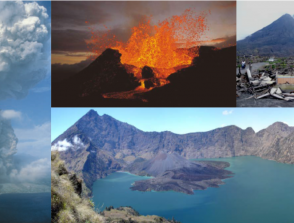ANR Plum-BeatR: Réunion Plume Beat and the Rheology of the Mantle
Start: 01/12/2023 - End: 31/12/2027
European partnership, International partnership outside Europe
Host institutions :
IPGP, Institut de physique du globe de Paris
Partner institutions :
Université Claude Bernard-Lyon 1
Related teams :
Volcanic Systems
Plum-BeatR: Réunion Plume Beat and the Rheology of the Mantle
Project funded by the French Agence Nationale de la Recherche (ANR), under grant “ANR- 23-CE49-0009 (project Plum-BeatR)”
Many hotspots worldwide display evidence of fluctuating magmatic emplacement rates in their history. Time-series analysis shows that they vary regularly at periods of 1-20 Myr, indicative of changing melt production within underlying mantle plumes. Hotspot fluctuations provide promising information about the nature and dynamics of plumes and the elusive mantle rheology. Hotspot fluctuations may thus help to resolve a longstanding debate about mantle rheology, by constraining upper-mantle viscosity which varies over 3 orders of magnitude.
Recently, we have identified coeval pulses of magmatic activity and rest in two volcanic islands of the Réunion hotspot (La Réunion and Mauritius, Mascarene archipelago) with periodicities of 200 to 400 kyr over the past 4 Myr, an order of magnitude shorter than any fluctuation found elsewhere. Given the distance between the two islands (~230 km), this synchronous short-period pulsation of the Réunion hotspot cannot stem from the lithosphere (≤70 km thick), and must therefore be related to plume processes occurring in the asthenosphere or deeper.
The objective of this project is to fully characterise the periodicity, amplitude, and compositional variations of the Réunion hotspot pulsation, and to unravel the geodynamic processes behind this beat, to ultimately improve our understanding of mantle rheology and dynamics. We will combine observations from geology, geochronology, and geochemistry with methodological developments in geomorphology and numerical modeling of plume-mantle-lithosphere interaction, for the following knowledge production, subdivided into three work packages (WP):
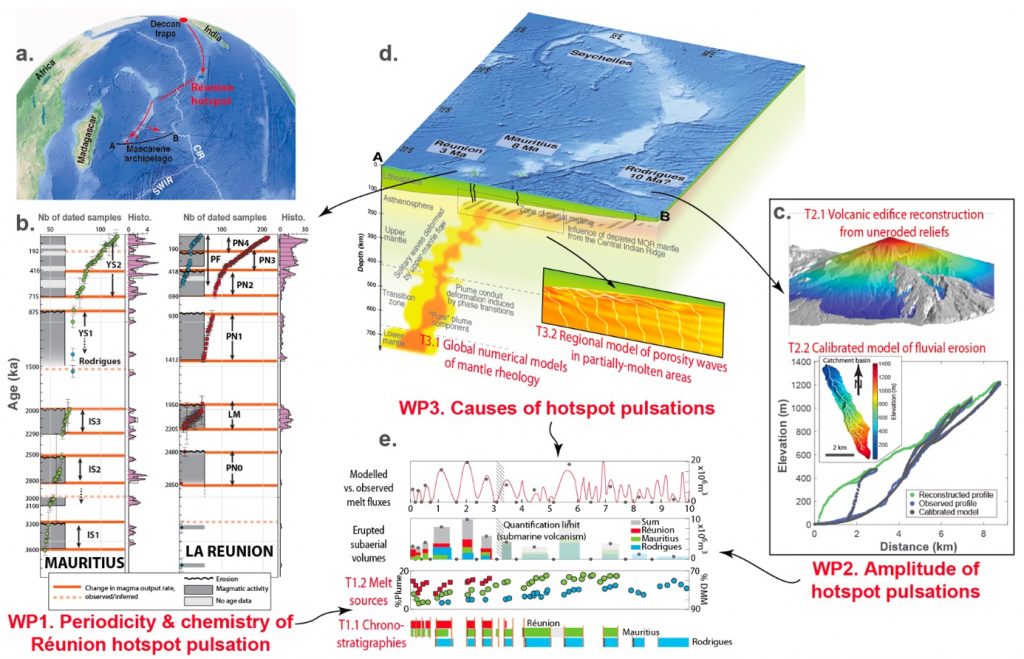
Figure 1: Objectives and strategy of the Plum-BeatR project. a/ Track of the Réunion hotspot in the Indian Ocean. b/ Compared chronostratigraphies of Mauritius and Réunion showing synchronous phases of volcanism and quiescence over the past 4 Ma (Famin et al., in prep.), to be extended to 10 Ma and toward Rodrigues. c/ Determination of erupted volumes since the emersion of the Mascarene islands. d/ Geodynamic processes investigated to explain the causes of hotspot pulsation. e/ Expected quantitative comparison of observations and numerical models (red, green and blue colors for Réunion, Mauritius, and Rodrigues, respectively).
WP1: Periodicity of the Réunion hotspot pulsation in space (toward Rodrigues, the third island of the Mascarene archipelago) and time (up to 10 Ma instead of 4 Ma), at an unprecedented temporal resolution for a hotspot (10-50 kyr). By building comprehensive chronostratigraphic charts of the islands and chronicles of major, trace element and Sr-Nd-Pb isotopic compositions in emitted magmas, we will explain this hotspot pulsation in terms of variable melt sources and degrees of partial melting, with implications on the dynamics of the plume.
WP2: Amplitude of hotspot pulsation since the emersion of the Mascarene islands. To estimate magma emission rates at the targeted temporal resolution of 10-50 kyr over 10 Ma, we will develop new geomorphological tools taking erosion into account to allow precise volume quantification of island construction.
WP3: modelling the causes of hotspot pulsation. Adopting two state-of-the-art modeling strategies, we will test whether the Réunion hotspot beat can arise from compositional heterogeneities, conduit deformations in the asthenosphere or deeper, melt propagation properties, or plume-lithosphere interaction. The StagYY code will allow us to run fully-dynamic 3D-spherical-patch models of whole-mantle convection with plate tectonics at an unprecedented high spatial (<25 km) and temporal (~25 kyr) resolution necessary to quantify short-period plume fluctuations. We will also test the hypothesis that pulsations originate from porosity waves induced by partial-melt upward migration, using the software TerraFERMA.
The project is led by Vincent Famin (Volcanic Systems team, IPGP) and Maëlis Arnould (University Claude Bernard – Lyon 1), and involves eleven members from seven international institutes in four different countries. Two PhD students will be hired and trained in the frame of the project.

Figure 2: Examples of combined fieldwork and geochronology to establish the chronostratigraphic charts of volcanic islands in WP1. a/ Relief inversion showing a major unconformity, bracketed by two radiometric ages in Réunion (Famin et al., in prep.). b/ Lava flow covering a paleo-soil and colluviums, and sampled for radiometric dating, Rodrigues. c/ Fresh lava flow filling an incised valley and covering altered basalt, both sampled for dating, Rodrigues.
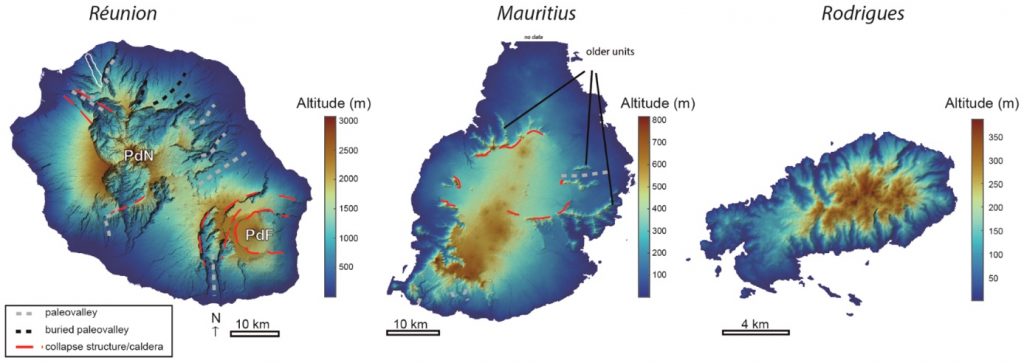
Figure 3: Topographic framework of Réunion, Mauritius and Rodrigues islands (Gourbet et al., in prep.). Note the distribution of relict relief features on Mauritius Island and the symmetry of radial valleys in Rodrigues Island. PdN: Piton des Neiges; PdF: Piton de la Fournaise.
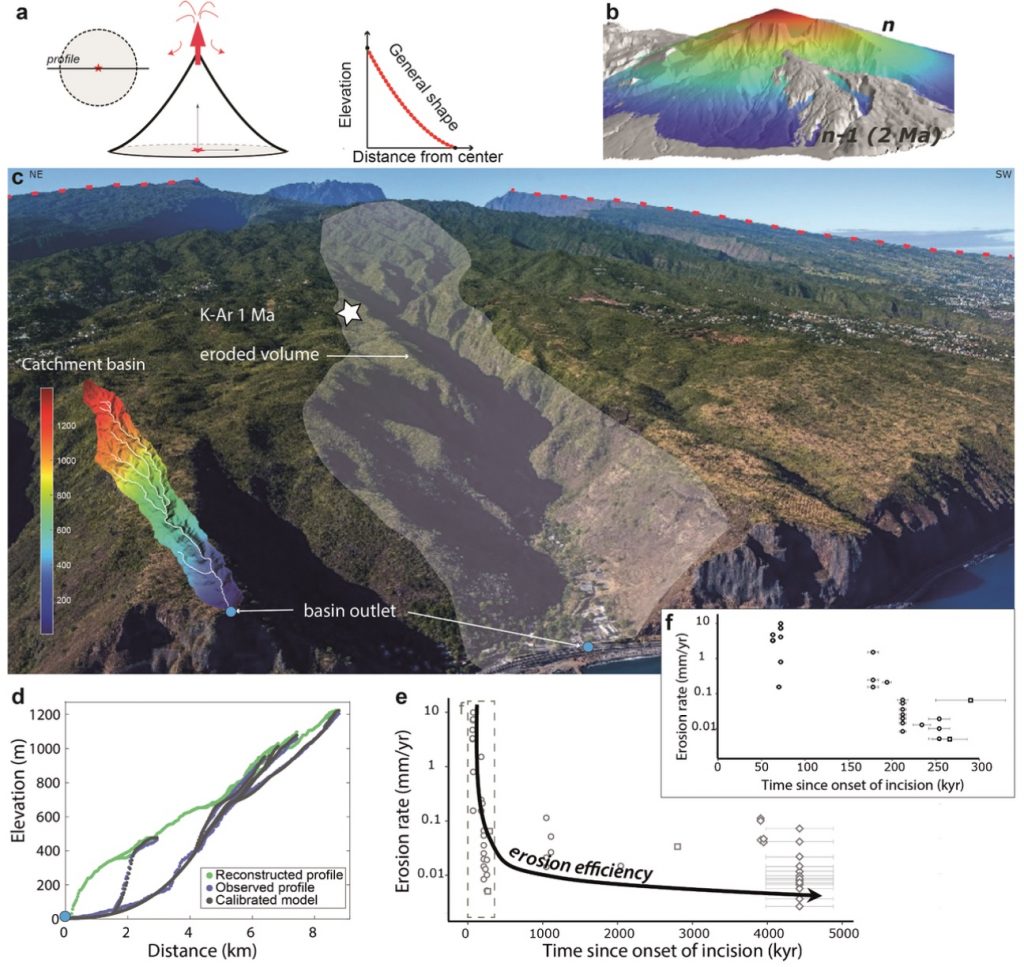
Figure 4: Methodologies used to reconstruct the pre-erosion volumes of emitted magmas. a/ Theoretical volcano presenting a conical shape with changing slope (Gayer et al., 2021). Red star: location of the center of eruptions. The same volcano represented in a Distance-to-Center vs Elevation diagram. The red points are equivalent to the red dotted line on c. b/ Example of 3D reconstruction of a volcano at stage n (Piton des Neiges, Réunion) filling a paleorelief in gray (stage n-1). c/ View of Piton des Neiges with a catchment basin, dissected by fluvial incision, delineated in white. Picture by F. Larrey. d/ 2D view of the same catchment basin, with the river’s paleo- and observed profiles compared to the profile corresponding to the best-fit stream power law parameters recovered from inverse modeling. e/ Basin-averaged erosion rates decrease as a function of the age of the incised surface, with a close-up f. of the 0-300 kyr time range (Gourbet et al., in rev.).

Figure 5: Strategy of geodynamic modelling applied to tracking plume pulsations. a/ Time series of the activity of a mantle plume tracked in a 3D-spherical model of mantle convection with surface tectonics and a simple rheology. Shortest-scale pulsations are of the order of 2-10 Myr (from Arnould et al., 2020). T3.1’s reference model will be built using the same parameterization. b/ 3D-spherical patch geometry of the models developed during T3.1. Model viscosity is shown in transparent colors while a hot yellow isotherm highlights the presence of several mantle plumes within the model. The plume at the front with the thermal trail highlighted in white interacts with a ridge.
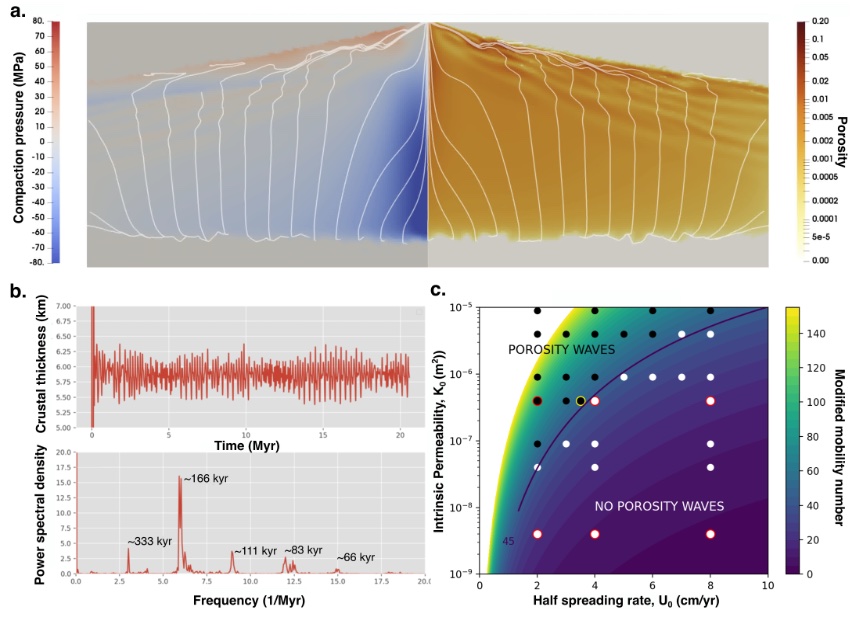
Figure 6: Example of 2D two-phase flow models with the software TerraFERMA in a mid-oceanic ridge context, to be applied to the Réunion hotspot. a. Geometry of the model, showing the compaction pressure on the left and porosity on the right. Note the presence of porosity waves on the right panel (Sim, 2022). b. Time series of model crustal thickness as a proxy for melt production variations, and corresponding spectral density (Parnell-Turner et al., 2020). c. Parameter map showing how the generation and persistence of porosity waves depends on the intrinsic permeability and the half-spreading rate in a ridge context. The modified mobility number gives a sense of how fast the fluid moves compared to solid advection (Sim, 2022).





